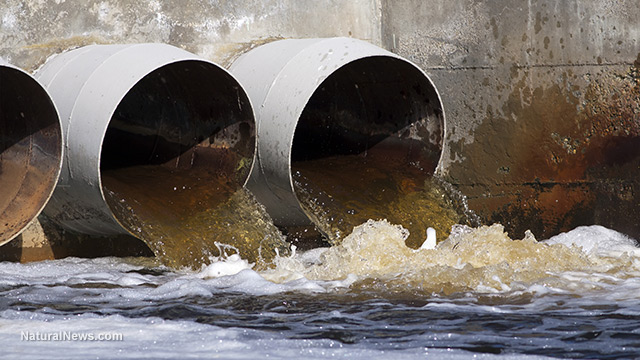Wastewater discharge into streams can lead to rapid antibiotic resistance, bacterial infections and disease
Monday, May 02, 2016 by: David Gutierrez, staff writer
Tags: superbugs, antibiotic resistance, wastewater

(NaturalNews) Discharges from wastewater treatment plants (WWTPs) may be a major contributor to the evolution of antibiotic resistance in the wild, according to a study partially funded by the European Regional Development Fund.
Bacteria naturally possess an intrinsic resistance to toxic chemicals, including antibiotics, and new resistance may also develop naturally through mutation. But scientists agree that widespread overuse of antibiotics has rapidly accelerated the evolution of antibiotic resistance, by killing off bacteria without resistance and strongly favoring those that possess it to pass their genes on to future generations. The process has been further accelerated by a bacterial ability known as "horizontal gene transfer," which allows bacteria to swap genes with each other, even between different species.
Drug resistance four times more common downstream
It has been known for some time that humans and other animals treated with antibiotics do not metabolize the entire drug, and that a biologically significant amount then passes back into the environment along with their waste. These trace amounts of chemicals cannot be removed by WWTPs. In the new study, the researchers sought to test whether – as many scientists have proposed – this can actually lead to the spread of antibiotic resistance among bacteria later exposed to this treated wastewater.The study was performed in Spain's Tordera River Basin, which receives input from WWTPs and numerous, well-separated locations. Researchers collected bacterial samples from "river biofilms," the layers of microbial slime that form on rocks, plants and other surfaces within rivers. These samples were then tested for the presence of genes conferring resistance to major families of antibiotics commonly used in human medicine, including fluoroquinolones, macrolides and sulfonamides.
The researchers found that WWTPs were responsible for several changes to the natural characteristics of the four streams tested. Downstream of WWTPs, the stream flow, water conductivity, nitrogen content and phosphorus content of the water was higher, relative to samples collected upstream. In addition, there was a significantly higher prevalence of antibiotic-resistant genes in samples taken downstream of WWTPs. For example, a gene conferring resistance to the popular antibiotic was four times more prevalent in downstream biofilms than in upstream ones.
Antibiotic resistance genes were found at elevated levels as far as 1 km downstream of WWTPs. This could indicate that drug-resistant bacteria are actually being discharged from the WWTPs and floating downstream. It might also mean that a high concentration of antibiotics in discharged wastewater is causing the evolution of drug-resistant bacteria downstream of WWTPs, with those bacteria and their genes then spreading downstream from that point. Alternatively, there might be additional sources of wastewater discharge downstream of the WWTPs that the researchers were not aware of.
Environmental laws inadequate
A press release from the Environment Directorate General of the European Commission draws attention to several implications of the findings. First, the press release emphasizes the key finding of the study: that discharges from WWTPs are likely contributing to the accelerated evolution of antibiotic resistant bacteria. It also notes that some of this evolution may be taking place within river biofilms themselves, which may provide an ideal setting for horizontal gene transfer. The authors also suggest that river biofilms could be further studied as honest indicators of pharmaceutical pollution in surface water ecosystems.The press release notes that wastewater discharges might, in some cases, raise antibiotic levels above the established environmental quality standard (EQS) set by the European Union, and that in such a case, member states would be responsible for lowering those levels. WWTP discharges might cause other changes in streams requiring member state action.
But, the press release notes, EQS are set solely based on levels of chemicals that cause acute poisoning. They do not take into account the specific threat posed by antibiotics, that of accelerating the evolution of drug resistance.
The press release notes that a change in the laws regulating antibiotic levels in water may be called for.
Sources for this article include:
Environmental-Expert.com
NaturalNews.com
NaturalNews.com
Science.NaturalNews.com
Superbugs at FETCH.news
Get independent news alerts on natural cures, food lab tests, cannabis medicine, science, robotics, drones, privacy and more.
Take Action: Support Natural News by linking to this article from your website
Permalink to this article:
Embed article link: (copy HTML code below):
Reprinting this article:
Non-commercial use OK, cite NaturalNews.com with clickable link.
Follow Natural News on Facebook, Twitter, Google Plus, and Pinterest
- Newly released JFK files reveal Pentagon's role in creating Lyme disease and covid in the same lab
- Trump nominates VACCINE ZEALOT Susan Monarez to lead the CDC, sidelining RFK Jr.'s reform efforts
- Obama accused of laundering USAID funds to fuel global protest movements, regime change operations
- HUGE: Putin claims 2020 election fraud in U.S. sparked Ukraine war, calls for peace talks with Trump
- Deep State in disarray: Trump's funding freeze sows chaos, Democrats vow legal battle
- Trump shows his true colors
- STARDUST, a secretive Israeli-US startup, plans risky solar geoengineering experiment to BLOCK OUT THE SUN
- Trump's greatest betrayal so far: Accelerating Middle East wars, silencing dissent, and serving Zionist masters
- $2B Roundup verdict: A landmark blow to Bayer and a win for health freedom
- Outrageous government fraud: $312M in COVID loans went to children as young as 9 months old
- Festive flavors: The sweet history, nutritional profile and health benefits of pecan pie
- Elon Musk: Aliens could be here on Earth RIGHT NOW
- Dr. Mike Yeadon releases 15-minute testimony - WATCH - about genocidal intent of COVID “vaccines”
- SWEET SABOTAGE: CIA's secret war on Soviet sugar revealed in JFK files
- “Forever chemicals” in drinking water drive alarming cancer surge, new study warns
- A mysterious startup is developing a new form of solar geoengineering
- Govt. agency closed by DOGE looked like a palace inside, with oil paintings fit for a KING...
- “Behind the Green Mask”: Rosa Koire exposes the hidden agenda of UN Agenda 21
- Newly released JFK files reveal Pentagon's role in creating Lyme disease and covid in the same lab
- Elon Musk: Aliens could be here on Earth RIGHT NOW
- Reclaim your health: How midlife exercise reverses years of inactivity
- Trump reverses course on Gaza plan, says “nobody is expelling Palestinians”
- EPA advisor admits the agency is funneling billions to climate groups ahead of Trump’s return to White House
- Big Pharma's $8 Billion bribery scheme exposed: how doctors are pushed to prescribe junk science, not heal
- Space war brewing? Russia threatens to destroy Starlink satellites
- A lack of integrity in Academia: Harvard professor found GUILTY of fraudulent research to promote CRT theory
- Survival 101: Effective EMF blocking techniques
- Rep. Nancy Mace introduces bill to ban biological males from female facilities on federal property
- Mike Adams Sermon 66: God will DESTROY ISRAEL for its wickedness
- Pilots report mysterious lights 'moving at extreme speeds' across Oregon skies
- 5 Simple steps to boost your brainpower: How to strengthen executive function in a distracted world
- Historian warns Israel may be entering an “IRREMEDIABLE DECLINE”
- Florida takes a stand: DeSantis proposes permanent ban on mRNA vaccine mandates
- RFK Jr.'s SSRI antidepressant investigation sparks liberal meltdown, exposes Big Pharma's dangerous game
- OpenAI whistleblower who dissented against how the company trained ChatGPT found dead
- Sugarcane extract superior to cholesterol-lowering drugs?
- EPA advisor admits the agency is funneling billions to climate groups ahead of Trump’s return to White House
- The Health Ranger releases “Vaccine Zombie” song and music video, using AI-animated zombies for the music video
- California's social media censorship law struck down: A victory for free speech or a threat to online safety?
- Dr. Mike Yeadon releases 15-minute testimony - WATCH - about genocidal intent of COVID “vaccines”
- The pandemic as a tool for INDOCTRINATION: Understanding “The Indoctrinated Brain” by Dr. Michael Nehls
- Mike Adams releases country western hit single: Goin’ Back in Time is Comin’ Home
- Mike Adams releases music poetry sensation: A Child of God
- RFK Jr. clears key hurdle: Sen. Susan Collins backs controversial HHS nominee, signaling a new era for health policy
- Florida takes a stand: DeSantis proposes permanent ban on mRNA vaccine mandates
- Unpacking the Lies That We’ve Been Fed – new song and music video released by Mike Adams, the Health Ranger
- Mike Adams releases new song and music video: Nothing More Disgusting Than a Globalist
- Congratulations to the FULLY UNVACCINATED as you resisted the COVID-19 PROPAGANDA MACHINE fueled by over $100 BILLION
- “Why we influenced the 2020 elections”: Facebook files reveal the coordinated effort to bury the Hunter Biden laptop story
- Michigan sheriff announces criminal investigation into 2020 election crimes, Dominion Voting Systems
- Israeli soldiers accused of even more torture and abuse in the West Bank
- Migrants are taking advantage of recent hurricanes to scam residents and loot their homes
- House Intelligence Committee calls for the ARREST and PROSECUTION of Dr. Anthony Fauci
- Peter Rost exposes Big Pharma corruption in his book “The Whistleblower: Confessions of a Healthcare Hitman”
- Red Cross issues warning to stop blood plasma donations from vaccinated people
- Scientists confirm: GENIUS brain function can be spontaneously unleashed in humans without any apparent cause
- EPA advisor admits the agency is funneling billions to climate groups ahead of Trump’s return to White House
- HYSSOP: What research reveals about the health benefits of this ancient holy herb
- Two containers with completed ballots fall out of truck in Florida
- Fully vaccinated about to see “tsunami” of illness and death, warns virologist
- Global leaders unite to clamp down on “misinformation” with UN-backed Cascais Declaration
- BREAKING: 2025 NDAA authorizes mandatory military draft of WOMEN across America… as Pentagon pursues global NUCLEAR war with both Russia and China at the same time
- Michael Yon warns of a ZIONIST TAKEOVER in Trump’s second administration
- BOMBSHELL: DNA testing kits are a SCAM to develop ethnic-specific bioweapons
- Ozempic and Wegovy weight loss drugs are injectable LIZARD VENOM PEPTIDES that may unleash a devastating wave of organ failure… side effects align with symptoms of SNAKE BITES
- Israeli soldiers accused of even more torture and abuse in the West Bank
- These 13 countries just signed an agreement to engineer a global FAMINE by destroying food supply
- NASA admits that climate change occurs because of changes in Earth’s solar orbit, and NOT because of SUVs and fossil fuels
- RFK Jr. clears key hurdle: Sen. Susan Collins backs controversial HHS nominee, signaling a new era for health policy
- Sermon 30: How Jesus reveals Caesar’s FAKE CURRENCY and FALSE AUTHORITY
- Coriander seeds: Ancient medicine backed by modern science
- Arizona officials claim Maricopa County needs 10-13 days to tabulate results of the election
Science News & Studies
Medicine News and Information
Food News & Studies
Health News & Studies
Herbs News & Information
Pollution News & Studies
Cancer News & Studies
Climate News & Studies
Survival News & Information
Gear News & Information
News covering technology, stocks, hackers, and more



"Big Tech and mainstream media are constantly trying to silence the independent voices that dare to bring you the truth about toxic food ingredients, dangerous medications and the failed, fraudulent science of the profit-driven medical establishment.
Email is one of the best ways to make sure you stay informed, without the censorship of the tech giants (Google, Apple, Facebook, Twitter, YouTube, etc.). Stay informed and you'll even likely learn information that may help save your own life."
–The Health Ranger, Mike Adams












































